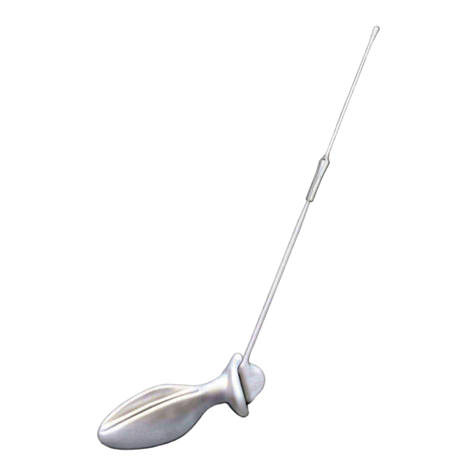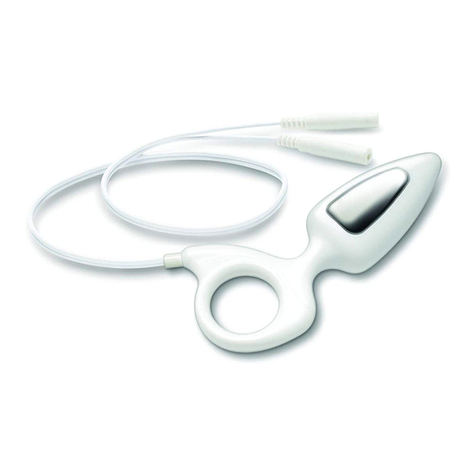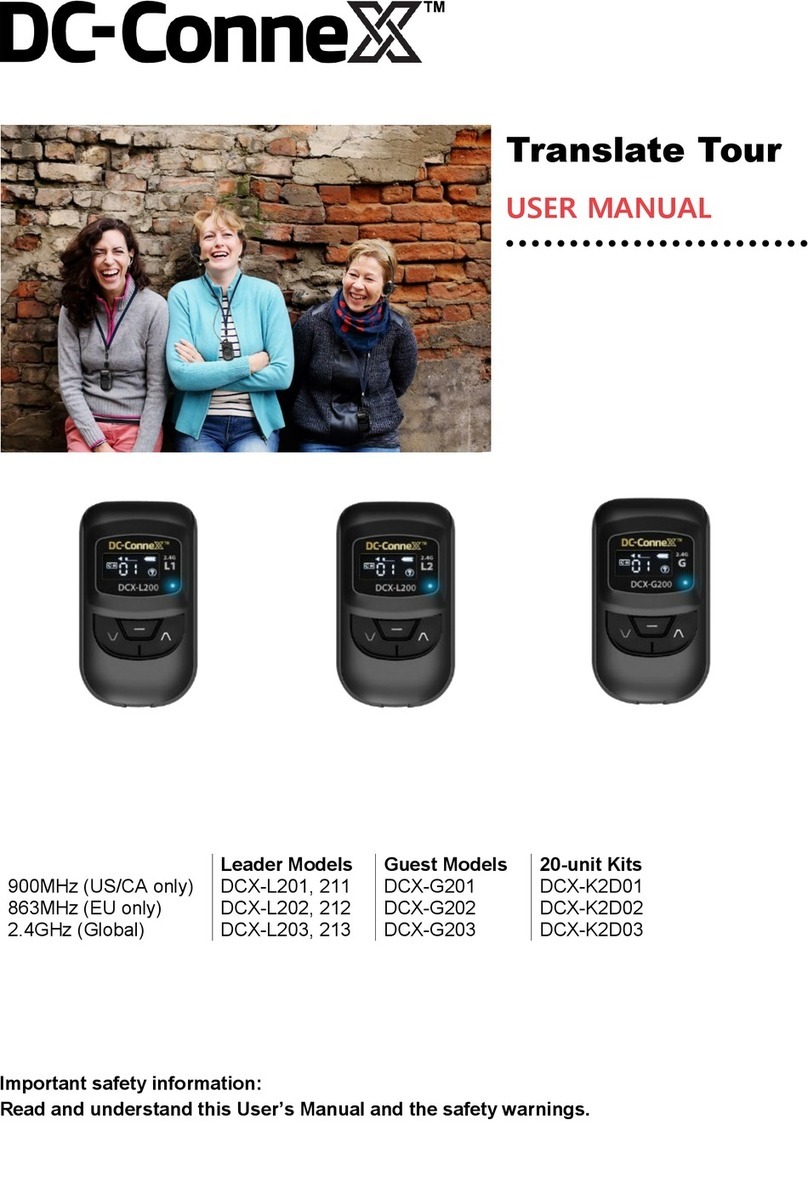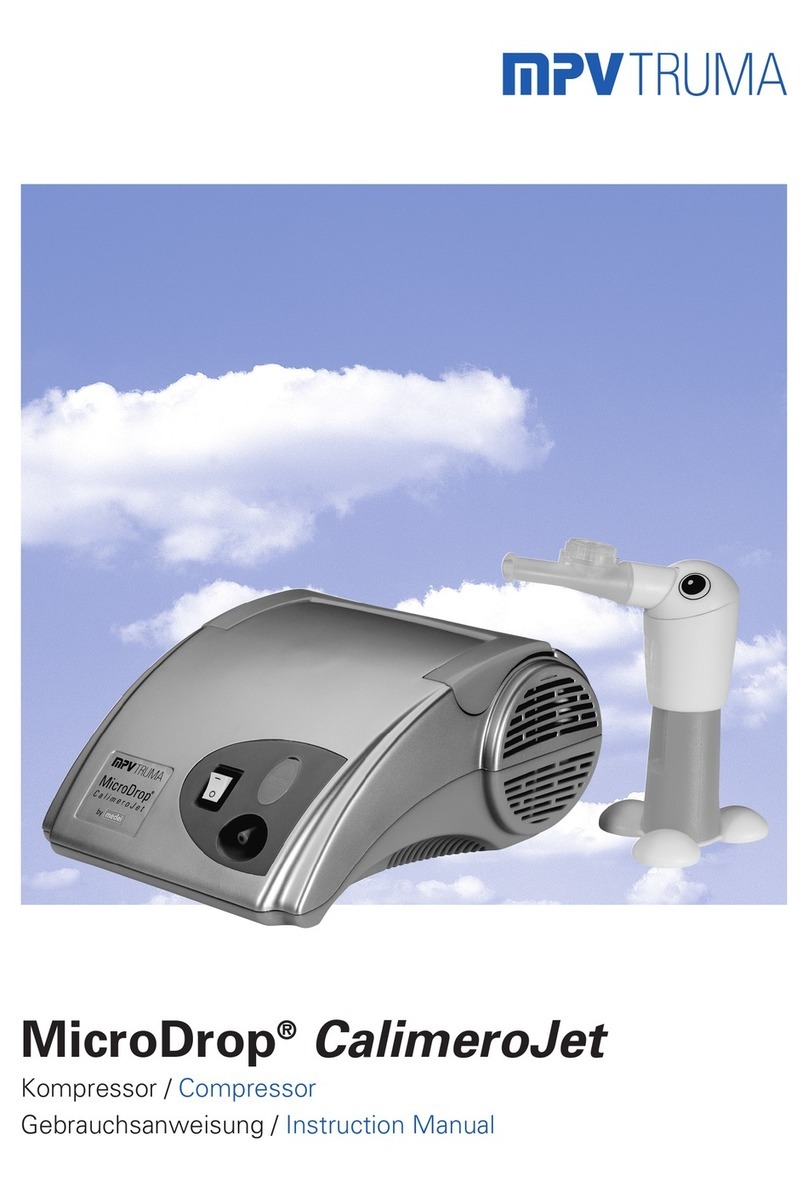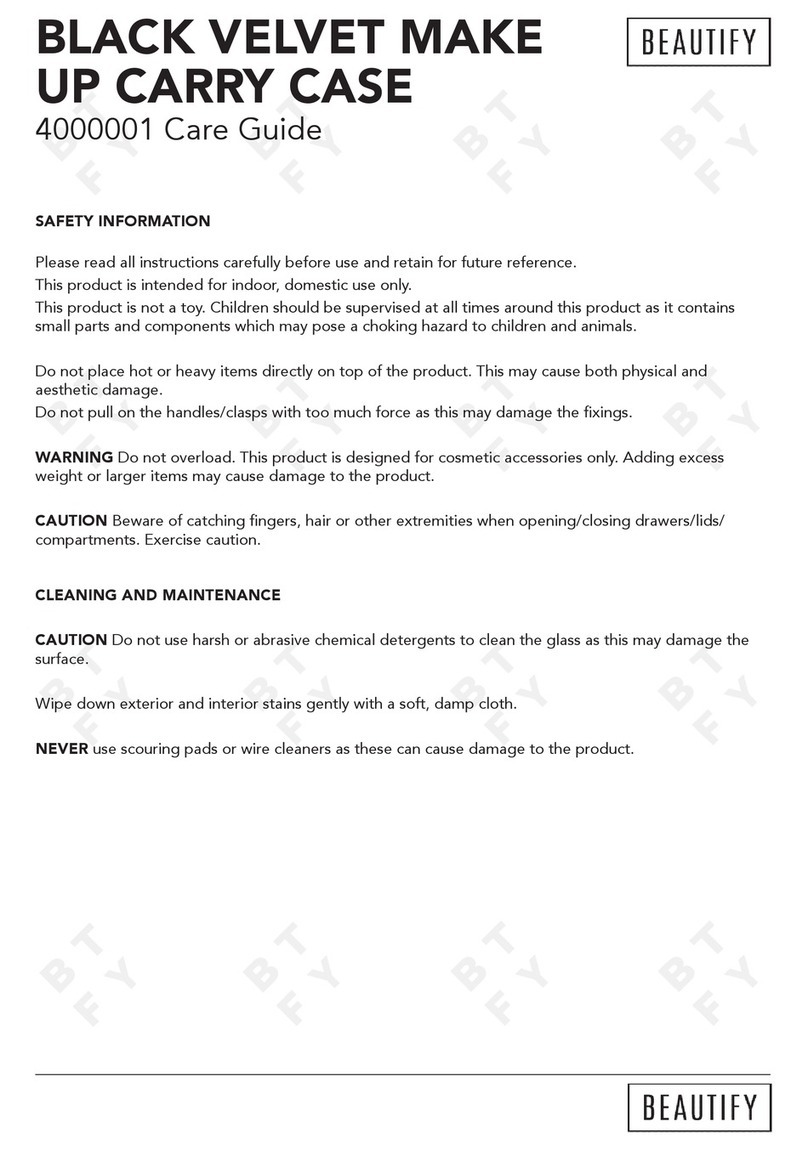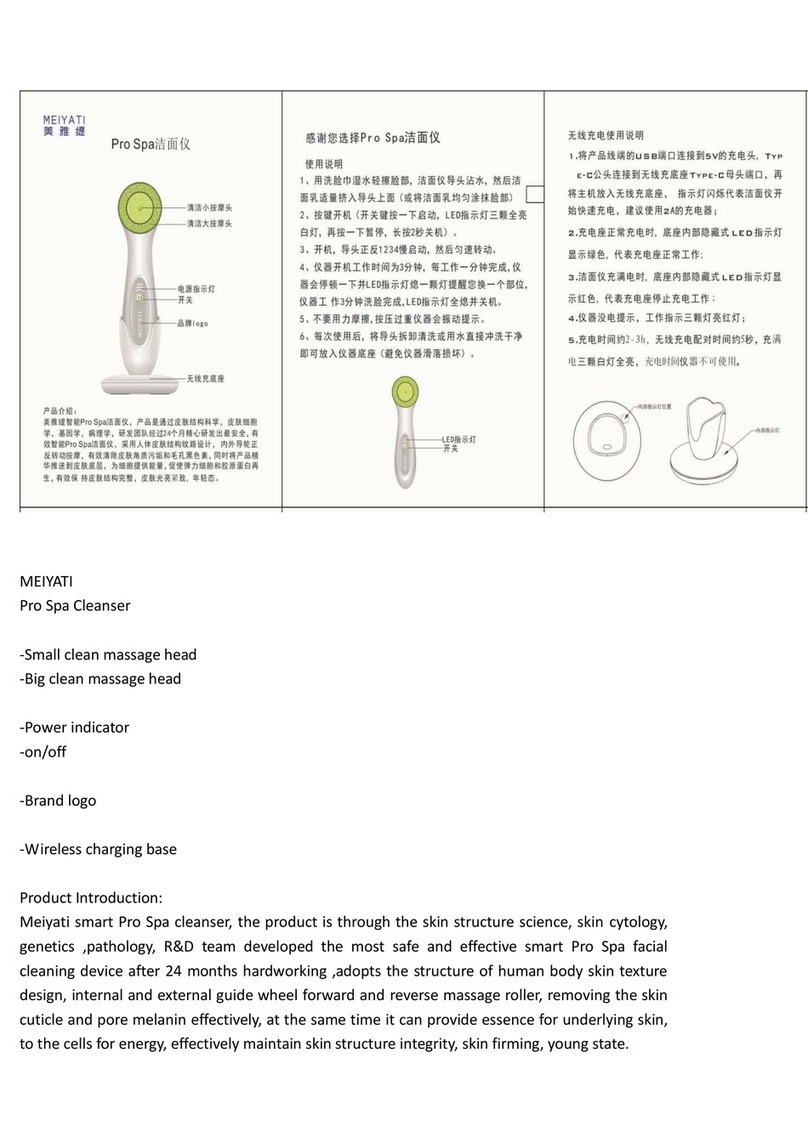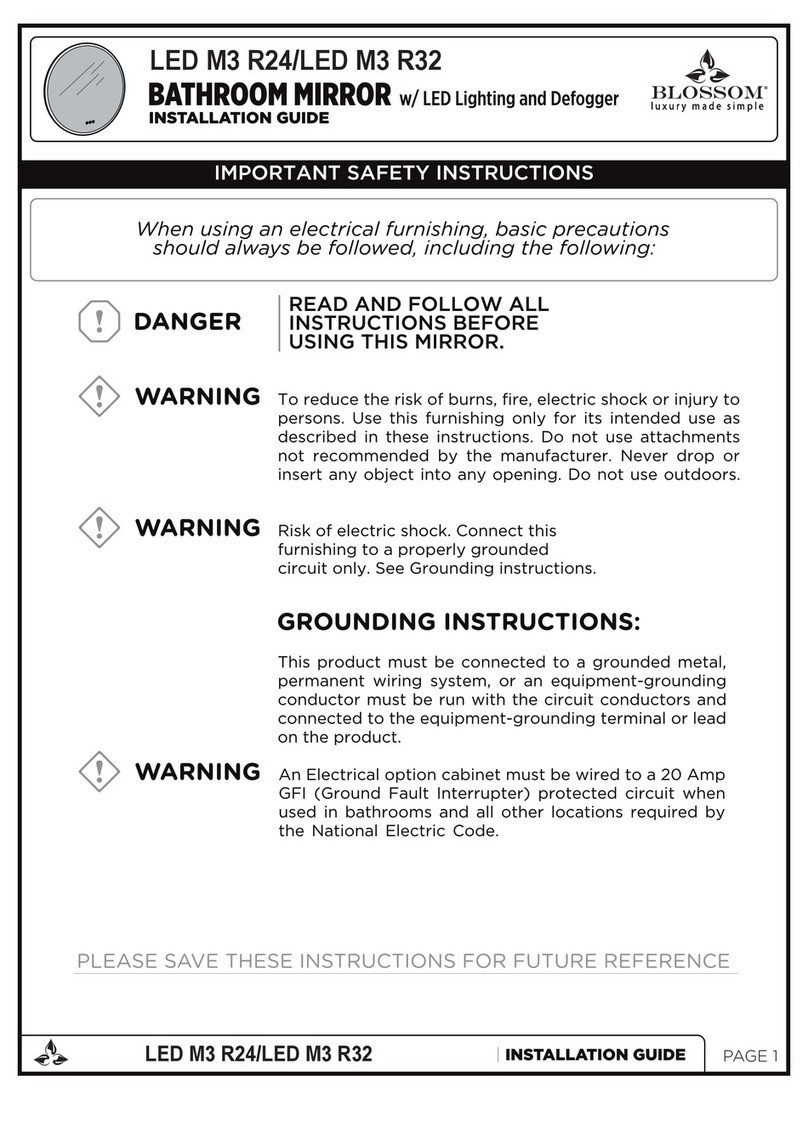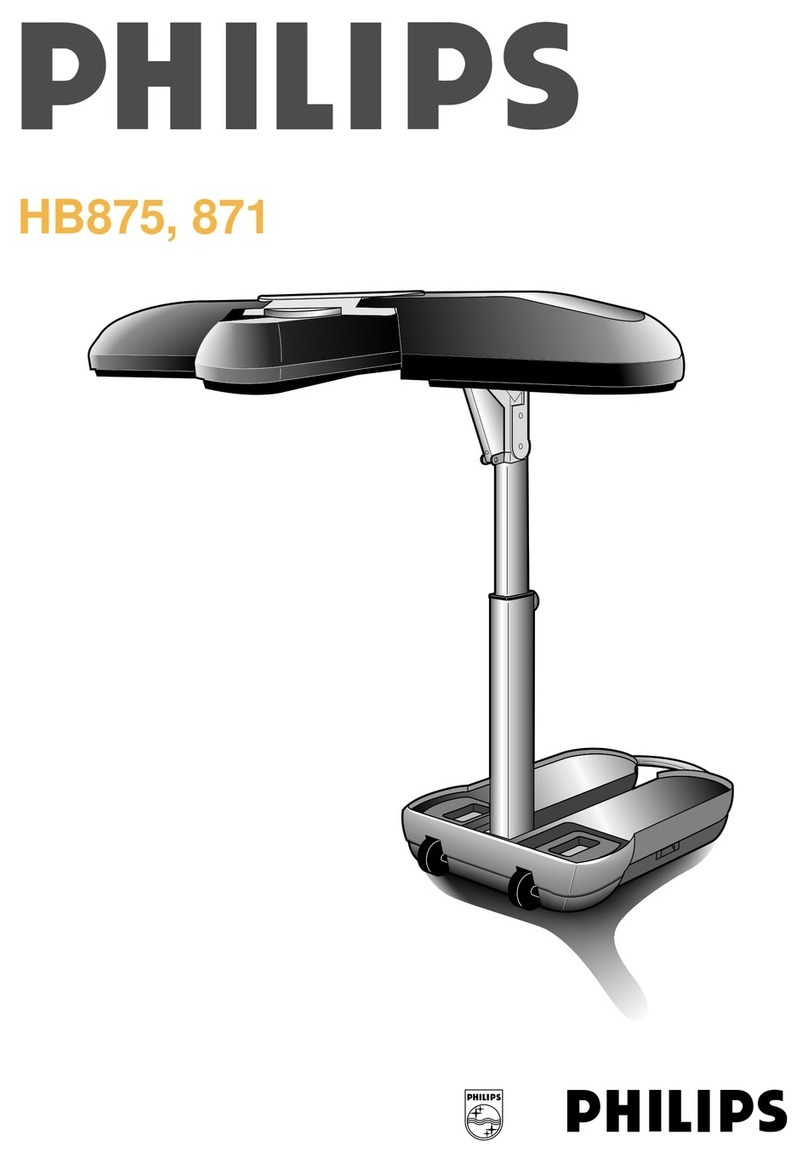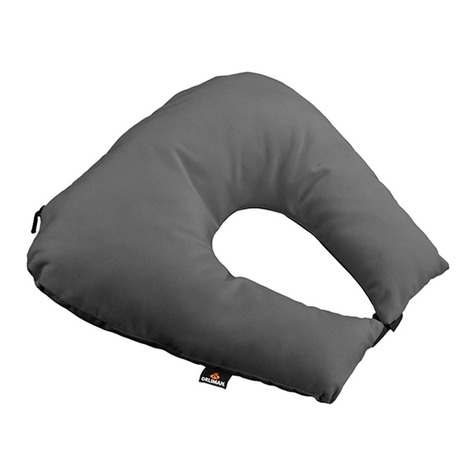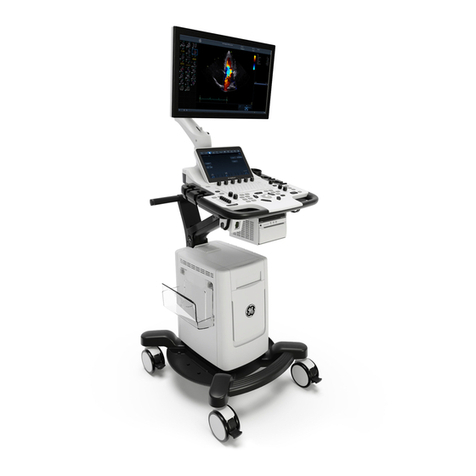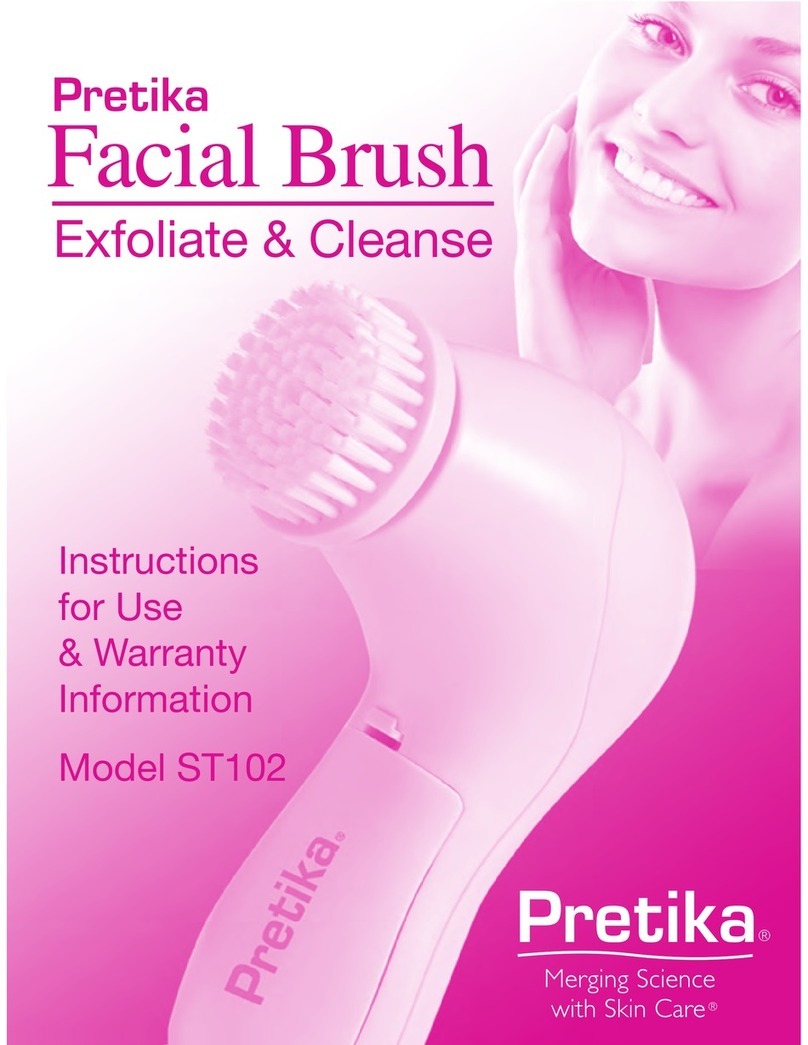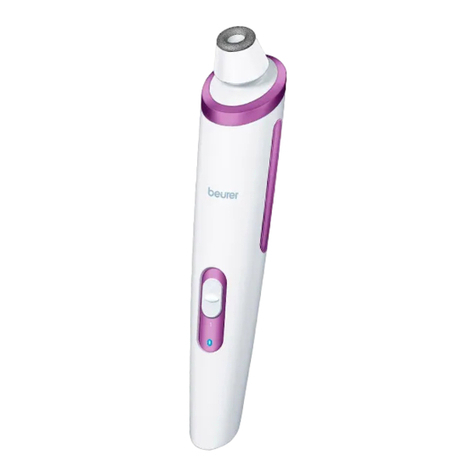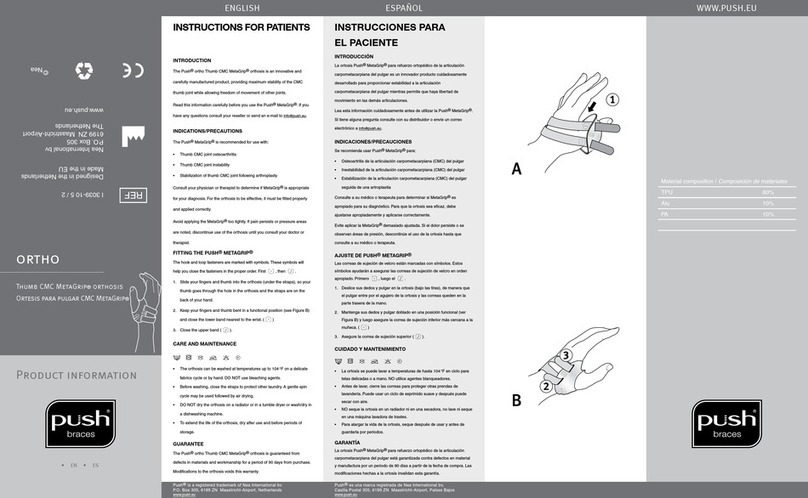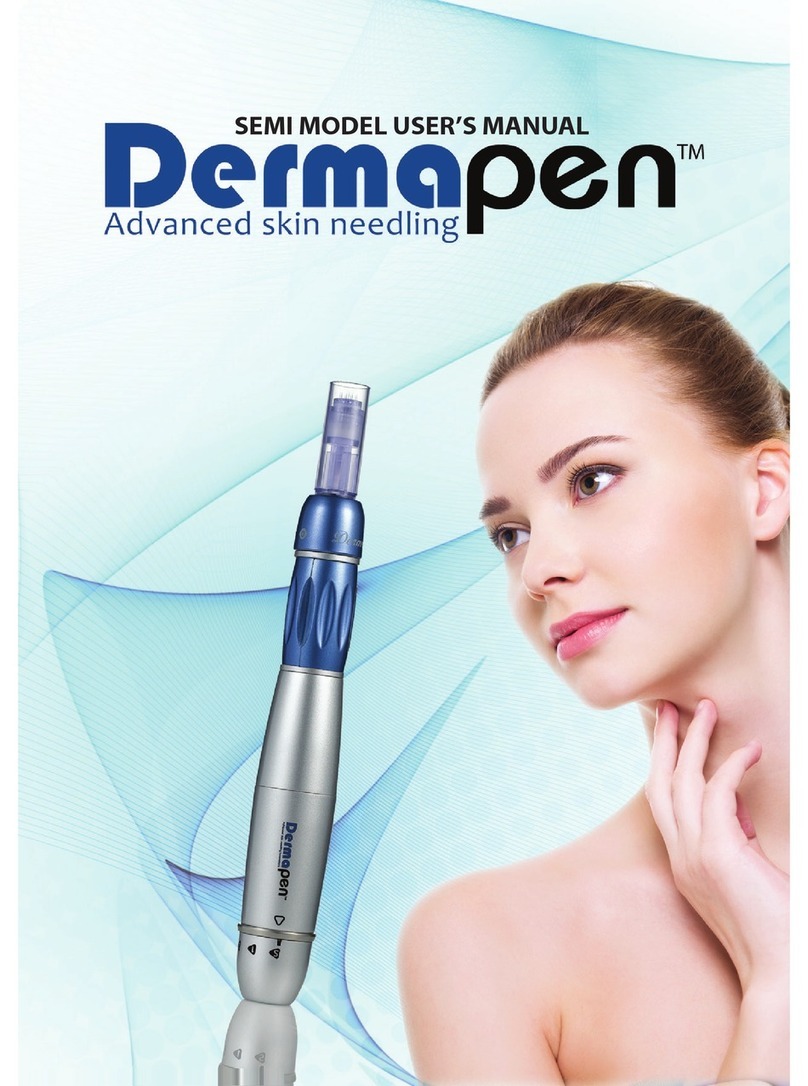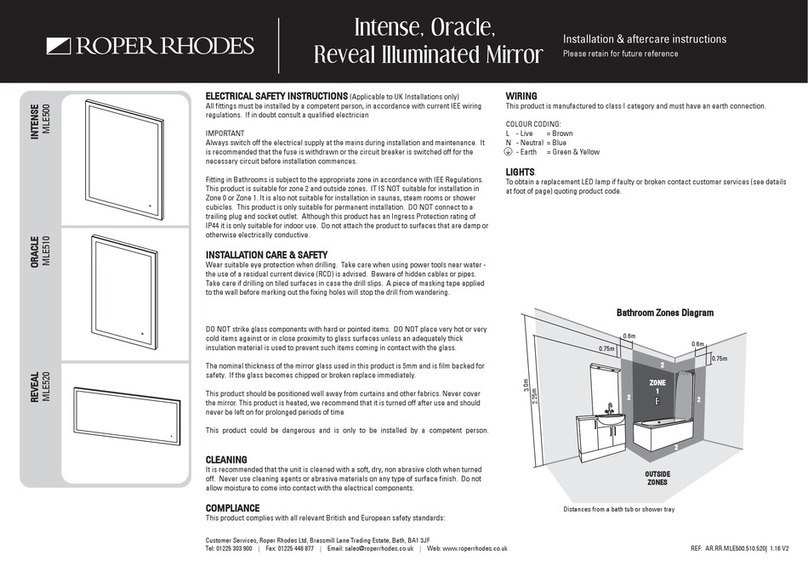Neen PERICALM User manual

Pericalm™
Instruction Manual

Pericalm™ Instruction Manual
Warnings
•This unit must be used with the guidance of a Physiotherapist,
Doctor or Continence Advisor
•Type BF equipment
•Do not insert lead wires into a mains power supply
•Do not immerse the unit into water or any other substance
•Do not use the unit in the presence of a ammable anaesthetic
gas mixture and air or with Oxygen or Nitrous Oxide
•If using rechargeable 9 volt PP3 Nickel Metal Hydride or Ni-Cad
batteries be sure to use a CE approved battery charger
•Never connect the Pericalm™ directly to a battery charger or any
other mains powered equipment
•Patient Electrodes are for single patient use only
•Use only CE approved vaginal or anal electrodes
i.e. Periform® or Anuform®
•Keep out of reach of children
2
This instruction manual is valid for the Neen Pericalm™ unit. It is
published by Neen Healthcare. Neen Healthcare does not guarantee
its contents and reserves the right to improve and amend it at any
time without prior notice.
Amendments will however be published in a new edition
of this manual.
Revised Issue Date: 31/10/2008 Document Number: VM-NEEN400-OM001-3

Pericalm™ Instruction Manual
Warnings
•This unit must be used with the guidance of a Physiotherapist,
Doctor or Continence Advisor
•Type BF equipment
•Do not insert lead wires into a mains power supply
•Do not immerse the unit into water or any other substance
•Do not use the unit in the presence of a ammable anaesthetic
gas mixture and air or with Oxygen or Nitrous Oxide
•If using rechargeable 9 volt PP3 Nickel Metal Hydride or Ni-Cad
batteries be sure to use a CE approved battery charger
•Never connect the Pericalm™ directly to a battery charger or any
other mains powered equipment
•Patient Electrodes are for single patient use only
•Use only CE approved vaginal or anal electrodes
i.e. Periform® or Anuform®
•Keep out of reach of children
2
This instruction manual is valid for the Neen Pericalm™ unit. It is
published by Neen Healthcare. Neen Healthcare does not guarantee
its contents and reserves the right to improve and amend it at any
time without prior notice.
Amendments will however be published in a new edition
of this manual.
Revised Issue Date: 31/10/2008 Document Number: VM-NEEN400-OM001-3
Pericalm™ Instruction Manual
3
Contents
2Warnings
4Introduction
5Contraindications & Precautions
6Description of Pericalm Unit & Functions
7Quick Start Instructions
9Continence Treatment Programmes
10 Electrode Types & Tips
11 Care & Maintenance
12 Disposal and Applications
13 Specications
14 Warranty
15 Clinical References

Pericalm™ Instruction Manual
Introduction
Neuromuscular stimulation is the electrical stimulation of muscle and
nerve bres that has been historically used as a form of pain relief and
pain prevention.
Therapists and Doctors have an increasing understanding of the mechanisms
which exist between muscles and nerves that in turn, makes it possible
to stimulate the neuromuscular system with precise electrical signals
to achieve a desired response.
The Pericalm™ is one of a new breed of modern neuromuscular stimulators.
It is a digital, dual channel unit and is used in the treatment of patients
suering with symptoms of Stress Incontinence, Urge Incontinence and
a combination of the two. The Pericalm™ also has a programme for
a pelvic oor workout, for pain relief and has three customisable
programmes so the user can set their own parameters.
The Pericalm™ should be used in conjunction with a Periform®
(vaginal electrode), an Anuform® (anal electrode) or surface electrodes.
These need to be purchased separately.
Please contact us about our Vaginal and Anal Probes. Tel: 0161 925 3180
Customer Care
We welcome constructive comments for the future
4
Pericalm™ Instruction Manual
Contraindications & Precautions
Before using this equipment you must rst seek the advice of your
Physiotherapist, Doctor or Continence Advisor.
Read this operating manual before using the Pericalm™
The Pericalm™ should not be used:
•By patients tted with a demand style cardiac pacemaker unless
so advised by their Doctor
•During pregnancy [unless medically advised]
•By patients with undiagnosed pain conditions
•By patients with undiagnosed skin, vaginal or anal conditions
•With patients who have diminished mental capacity or physical
competence who cannot handle the device properly
•On anaesthetised or desensitised skin
•When driving a vehicle or operating potentially dangerous equipment
•If you have recently had any urinary tract infection or vaginal infection
treated prior to using the unit
•If you have any active disease in the area
•If there is any tissue damage in the area until it is healed
Do not place electrodes:
•Over carotid sinus nerves
•Over larynx or trachea
•Inside mouth
•Over the area of the heart unless so advised by your Doctor
•On your facial area unless under strict guidance from a qualied Clinician
•Take further advice before using if you have diabetes or uncontrolled
blood pressure
•If you have had any abnormal cervical smears - do not use the unit until
you are returned to ‘normal’ time between smears
•The patient should only use the unit as prescribed
If considering using the Anuform® (anal electrode) do not use if:
•You are suering with acute haemorrhoids
•You have an anal ssure
•You have an acute attack of IBD (Crohns / Ulcerative Colitis) of the
lower bowel
5

Pericalm™ Instruction Manual
Contraindications & Precautions
Before using this equipment you must rst seek the advice of your
Physiotherapist, Doctor or Continence Advisor.
Read this operating manual before using the Pericalm™
The Pericalm™ should not be used:
•By patients tted with a demand style cardiac pacemaker unless
so advised by their Doctor
•During pregnancy [unless medically advised]
•By patients with undiagnosed pain conditions
•By patients with undiagnosed skin, vaginal or anal conditions
•With patients who have diminished mental capacity or physical
competence who cannot handle the device properly
•On anaesthetised or desensitised skin
•When driving a vehicle or operating potentially dangerous equipment
•If you have recently had any urinary tract infection or vaginal infection
treated prior to using the unit
•If you have any active disease in the area
•If there is any tissue damage in the area until it is healed
Do not place electrodes:
•Over carotid sinus nerves
•Over larynx or trachea
•Inside mouth
•Over the area of the heart unless so advised by your Doctor
•On your facial area unless under strict guidance from a qualied Clinician
•Take further advice before using if you have diabetes or uncontrolled
blood pressure
•If you have had any abnormal cervical smears - do not use the unit until
you are returned to ‘normal’ time between smears
•The patient should only use the unit as prescribed
If considering using the Anuform® (anal electrode) do not use if:
•You are suering with acute haemorrhoids
•You have an anal ssure
•You have an acute attack of IBD (Crohns / Ulcerative Colitis) of the
lower bowel
5

Pericalm™ Instruction Manual
Description of Pericalm™ Unit & Functions
6
* PRG button Selects the desired programmes - PR, STR1-2, URGE, FURG,
PFW, MEM1-3.
* SET button Hold down for three seconds. Changes the parameters Pulse
Rate, Pulse Width and Time for custom programmes MEM1-3.
Lock
button
Channel A Channel B
Power
Battery
compartment
LCD Display
Selects
Programme
Channel A
Increase Intensity
Channel A
Decrease Intensity
Channel B
Increase Intensity
Channel B
Decrease Intensity
Changes
parameters
(prev was Set)
Top
Rear
Front
Pericalm™ Instruction Manual
Quick Start Instructions
1. Insert a 9 volt PP3 Alkaline battery into the battery compartment.
(Can also use a rechargeable Nickel Hydride battery (which has
a longer life than the Ni-Cad rechargeable batteries)
2. Insert lead wire/s to channel A, and B if both channels are to be used.
Note: only one channel is required if using Periform or Anuform.
3. Attach lead wire/s to electrodes (vaginal, anal or surface electrodes).
4. Attach electrodes to correct body position. You should check with your
healthcare professional if you are in any doubt where to place electrodes.
5. Switch on the unit by pressing the Power button
6. Press the PRG (Programme) button to select one of the programmes
as detailed on page 9.
7. To start press channel A+ and B+ button if you are using both channels
until you reach the comfortable intensity.
8. To stop the programme, press the Power button which will turn the unit o.
Lock Button
A ‘concealed’ Lock button is included on the Pericalm™ which locks the
customised or built in programmes. It also allows the clinician to accurately
monitor ‘home compliance’of the patient between appointments.
To Lock the Unit
1. Select the pre-set or customised programme required. In the case of
a customised programme, make sure that the pulse width, frequency,
time etc. are set-up correctly.
2. Remove the battery cover and using a thin rod, gently press on the lock
button as shown in the diagram on page 6 until you hear a double beep.
The unit is now‘locked’ and cannot be altered until‘unlocked’
To Unlock the Unit
Remove the battery cover and press the lock button with a thin rod until a
single beep is heard. Now the LCD will display the average mA used on each
channel and the total hours the unit has been in use as shown in the diagram.
To return to normal ‘unlocked’ operation, simply press PRG.
7
Channel A
Hours Used
Channel B

Pericalm™ Instruction Manual
Description of Pericalm™ Unit & Functions
6
* PRG button Selects the desired programmes - PR, STR1-2, URGE, FURG,
PFW, MEM1-3.
* SET button Hold down for three seconds. Changes the parameters Pulse
Rate, Pulse Width and Time for custom programmes MEM1-3.
Lock
button
Channel A Channel B
Power
Battery
compartment
LCD Display
Selects
Programme
Channel A
Increase Intensity
Channel A
Decrease Intensity
Channel B
Increase Intensity
Channel B
Decrease Intensity
Changes
parameters
(prev was Set)
Top
Rear
Front
Pericalm™ Instruction Manual
Quick Start Instructions
1. Insert a 9 volt PP3 Alkaline battery into the battery compartment.
(Can also use a rechargeable Nickel Hydride battery (which has
a longer life than the Ni-Cad rechargeable batteries)
2. Insert lead wire/s to channel A, and B if both channels are to be used.
Note: only one channel is required if using Periform or Anuform.
3. Attach lead wire/s to electrodes (vaginal, anal or surface electrodes).
4. Attach electrodes to correct body position. You should check with your
healthcare professional if you are in any doubt where to place electrodes.
5. Switch on the unit by pressing the Power button
6. Press the PRG (Programme) button to select one of the programmes
as detailed on page 9.
7. To start press channel A+ and B+ button if you are using both channels
until you reach the comfortable intensity.
8. To stop the programme, press the Power button which will turn the unit o.
Lock Button
A ‘concealed’ Lock button is included on the Pericalm™ which locks the
customised or built in programmes. It also allows the clinician to accurately
monitor ‘home compliance’of the patient between appointments.
To Lock the Unit
1. Select the pre-set or customised programme required. In the case of
a customised programme, make sure that the pulse width, frequency,
time etc. are set-up correctly.
2. Remove the battery cover and using a thin rod, gently press on the lock
button as shown in the diagram on page 6 until you hear a double beep.
The unit is now‘locked’ and cannot be altered until‘unlocked’
To Unlock the Unit
Remove the battery cover and press the lock button with a thin rod until a
single beep is heard. Now the LCD will display the average mA used on each
channel and the total hours the unit has been in use as shown in the diagram.
To return to normal ‘unlocked’ operation, simply press PRG.
7
Channel A
Hours Used
Channel B

Pericalm™ Instruction Manual
Continence Treatment Programmes
The parameters in the table are suggested parameters only and should be used as that.
Please refer to the ACA Notes on Good Practice or The Chartered Society of
Physiotherapy Guidelines, to view the most up to date neuromuscular electrical
stimulation parameters.
As a clinician, you may prefer to use your own parameters to treat patients and it is
then ideal for you to use the customisable programmes MEM1-3.
9
6 Sequential phases:
Phase 1: 2Hz for 4 min,
Phase 2: 10Hz for 10 min,
Phase 3: 15Hz for 5 min,
Phase 4: 20Hz for 5 min,
Phase 5: 30Hz for 5 min,
Phase 6: 10Hz for 5 min
All phases are 5 seconds work, 5 seconds rest at 220 μS,
0.8 seconds ramp.
Programmes Hz PW
Ramp up Work Rest Overall
Rate μS
time in time in time in time in
seconds seconds seconds seconds
PAIN RELIEF 2 175 1 Cont Cont 25 min
PR
STRESS 1 30 200 1 5 5 25 min
STR1
STRESS 2 35 210 1 5 10 25 min
STR2
URGE 10 210 1 5 6 25 min
URGE
FREQUENCY/URGE
10 250 1 5 10 25 min
FURG
PELVIC FLOOR
WORK OUT AND
LACK OF
SENSITIVITY
(34 MIN)
PFW
CUSTOMISED
2 - 100 50 - 450
0.3 - 9.9 2 - 99 2 - 99 5 - 60
MEM 1
CUSTOMISED
2 - 100 50 - 450
0.3 - 9.9 2 - 99 2 - 99 5 - 60
MEM 2
CUSTOMISED
2 - 100 50 - 450 0.3 - 9.9
2 - 99 2 - 99 5 - 60
MEM 3
Pericalm™ Instruction Manual
Setting up the Customised Programmes MEM1-3
1. Select MEM1 for a constant programme by pressing the PRG button
on the front panel.
2. Hold down the SET button for three seconds to enter the setup menu.
The Hz symbol will flash.
3. Press the A+ or A- button select the desired Rate (Hz) from 2 to 100 Hz.
4. Press the SET button to select the Pulse width (μS). The μS symbol
will flash.
5. Press the A+ or A- button to select the desired Pulse Width from
50 to 450 μS.
6. Press the SET button to select the time. The MIN symbol will flash
and number of minutes will appear on the display.
7. Press the A+ or A- button to select the desired time from 5 to 60 minutes.
8. Press the SET button to select the work time in seconds WORK will
appear on the display. SEC symbol will flash.
9. Press the A+ or A- button to select the desired work time from
2 to 99 seconds.
10. Press the SET button to select the rest time in seconds REST will
appear on the display. SEC symbol will flash
11. Press the A+ or A- button to select the desired rest time from
2 - 99 seconds.
12. Press the SET button to select the ramp up time in seconds RAMP
will appear on the display. SEC symbol will flash
13. Press the A+ or A- button to select the desired ramp time from
0.2 - 9.9 seconds.
14. Pressing the SET button again will bring you back to the Rate setting.
15. Press the PRG button to save the programme. Repeat the above
procedure to re-programme.
Note: You must press the PRG button before locking the unit.
8

Pericalm™ Instruction Manual
Continence Treatment Programmes
The parameters in the table are suggested parameters only and should be used as that.
Please refer to the ACA Notes on Good Practice or The Chartered Society of
Physiotherapy Guidelines, to view the most up to date neuromuscular electrical
stimulation parameters.
As a clinician, you may prefer to use your own parameters to treat patients and it is
then ideal for you to use the customisable programmes MEM1-3.
9
6 Sequential phases:
Phase 1: 2Hz for 4 min,
Phase 2: 10Hz for 10 min,
Phase 3: 15Hz for 5 min,
Phase 4: 20Hz for 5 min,
Phase 5: 30Hz for 5 min,
Phase 6: 10Hz for 5 min
All phases are 5 seconds work, 5 seconds rest at 220 μS,
0.8 seconds ramp.
Programmes Hz PW
Ramp up Work Rest Overall
Rate μS
time in time in time in time in
seconds seconds seconds seconds
PAIN RELIEF 2 175 1 Cont Cont 25 min
PR
STRESS 1 30 200 1 5 5 25 min
STR1
STRESS 2 35 210 1 5 10 25 min
STR2
URGE 10 210 1 5 6 25 min
URGE
FREQUENCY/URGE
10 250 1 5 10 25 min
FURG
PELVIC FLOOR
WORK OUT AND
LACK OF
SENSITIVITY
(34 MIN)
PFW
CUSTOMISED
2 - 100 50 - 450
0.3 - 9.9 2 - 99 2 - 99 5 - 60
MEM 1
CUSTOMISED
2 - 100 50 - 450
0.3 - 9.9 2 - 99 2 - 99 5 - 60
MEM 2
CUSTOMISED
2 - 100 50 - 450 0.3 - 9.9
2 - 99 2 - 99 5 - 60
MEM 3
Pericalm™ Instruction Manual
Setting up the Customised Programmes MEM1-3
1. Select MEM1 for a constant programme by pressing the PRG button
on the front panel.
2. Hold down the SET button for three seconds to enter the setup menu.
The Hz symbol will flash.
3. Press the A+ or A- button select the desired Rate (Hz) from 2 to 100 Hz.
4. Press the SET button to select the Pulse width (μS). The μS symbol
will flash.
5. Press the A+ or A- button to select the desired Pulse Width from
50 to 450 μS.
6. Press the SET button to select the time. The MIN symbol will flash
and number of minutes will appear on the display.
7. Press the A+ or A- button to select the desired time from 5 to 60 minutes.
8. Press the SET button to select the work time in seconds WORK will
appear on the display. SEC symbol will flash.
9. Press the A+ or A- button to select the desired work time from
2 to 99 seconds.
10. Press the SET button to select the rest time in seconds REST will
appear on the display. SEC symbol will flash
11. Press the A+ or A- button to select the desired rest time from
2 - 99 seconds.
12. Press the SET button to select the ramp up time in seconds RAMP
will appear on the display. SEC symbol will flash
13. Press the A+ or A- button to select the desired ramp time from
0.2 - 9.9 seconds.
14. Pressing the SET button again will bring you back to the Rate setting.
15. Press the PRG button to save the programme. Repeat the above
procedure to re-programme.
Note: You must press the PRG button before locking the unit.
8

Pericalm™ Instruction Manual
Electrode Types & Tips
Both internal and external electrodes can be used with this unit.
They are single patient use only.
Internal electrodes:
014405 Periform® (vaginal electrode) 011503 Anuform® (anal electrode)
External self adhesive electrodes:
012571 50x50mm
012572 90x50mm
012573 130x50mm
012574 30mm diameter
012575 50mm diameter
012576 75mm diameter
Tips
•If using an internal electrode, after use always wash it in warm soapy
water, rinse and dry thoroughly and carefully store it for your next
treatment session.
•Never let anyone else use your electrode.
•Follow all instructions provided with the electrode.
•If using self adhesive electrodes always cleanse the skin with soap
and water, then rinse and dry well in order to ensure good adhesion
of the electrodes.
•Clip away hairy skin using scissors, do not shave the area
•After using surface electrodes, place them back on the plastic lm
they were packaged in and store them in a cool place i.e. the fridge.
•After repeated use, the sticky surface on the electrode will eventually
become dry. This surface is water based so by adding a few drops
of water will give you a few extra days of electrode life back!
10

Pericalm™ Instruction Manual
Electrode Types & Tips
Both internal and external electrodes can be used with this unit.
They are single patient use only.
Internal electrodes:
014405 Periform® (vaginal electrode) 011503 Anuform® (anal electrode)
External self adhesive electrodes:
012571 50x50mm
012572 90x50mm
012573 130x50mm
012574 30mm diameter
012575 50mm diameter
012576 75mm diameter
Tips
•If using an internal electrode, after use always wash it in warm soapy
water, rinse and dry thoroughly and carefully store it for your next
treatment session.
•Never let anyone else use your electrode.
•Follow all instructions provided with the electrode.
•If using self adhesive electrodes always cleanse the skin with soap
and water, then rinse and dry well in order to ensure good adhesion
of the electrodes.
•Clip away hairy skin using scissors, do not shave the area
•After using surface electrodes, place them back on the plastic lm
they were packaged in and store them in a cool place i.e. the fridge.
•After repeated use, the sticky surface on the electrode will eventually
become dry. This surface is water based so by adding a few drops
of water will give you a few extra days of electrode life back!
10
Pericalm™ Instruction Manual
Care & Maintenance
Control Unit:
•Wipe the surface after use with a damp cloth or antiseptic wipe
•Do not use cleaning sprays or alcohol based cleaning solutions
Battery:
•Check periodically for any discharge from the battery
•Remove battery completely from unit if not in use for any extended
period of time (typically one week)
•Low battery indicator of 6.9 volts shown on LCD display. When ashing
change battery for a new one
•Preferably use a PP3 alkaline battery
Lead Wires:
•
The lead wires should be handled carefully and never stretched, as this can
cause the stimulation to function below normal standards or not at all
•
Examine lead wires before each treatment for loose connections or damage
•Avoid twisting the lead wires
•Wipe lead wires after use with a damp cloth or antiseptic wipe
•Store the lead wires carefully after each use
Self-Adhesive Electrodes:
•
Check the short connectors have not become separated from the electrodes
•Replace electrodes onto plastic lm after use. If they drop onto the oor
debris will adhere to conductive gel rendering the electrodes ineective
Vaginal / Anal Probes
•Check the connectors have not become separated from the probe
•Before & after use always wash it in warm soapy water, rinse and dry
and carefully store
•
Never let anyone else use your electrode
•
Follow all instructions provided
with the electrode
Caution: Static electricity may damage this product
NOTE: Only Neen Healthcare or appointed distributors/importers are
approved to undertake servicing.
11

Pericalm™ Instruction Manual
Disposal
Applications
Information on disposal for users of Waste Electrical &
Electronic Equipment (WEEE) for private households:
Electrical and electronic products including batteries should not
be mixed with general household waste. For proper treatment,
recovery and recycling, please take these products to designated
collection points, where they will be accepted on a free basis.
•Promotes continence
•Increases muscle strength
•Maintains or improves range of movement
•Increases and improves the blood supply to the muscle
•Reduces pain
12

Pericalm™ Instruction Manual
Disposal
Applications
Information on disposal for users of Waste Electrical &
Electronic Equipment (WEEE) for private households:
Electrical and electronic products including batteries should not
be mixed with general household waste. For proper treatment,
recovery and recycling, please take these products to designated
collection points, where they will be accepted on a free basis.
•Promotes continence
•Increases muscle strength
•Maintains or improves range of movement
•Increases and improves the blood supply to the muscle
•Reduces pain
12
Pericalm™ Instruction Manual
Specifications
13
1. Dual channel: individually isolated circuits.
2. Amplitude: 0 - 90 mA; indication only; actual mA will tend
to be less than indicated due to electrode impedance.
3. Type: Constant Current.
4. Waveform: Asymmetrical, rectangular bi-phasic with zero
DC current.
5. Selectable pulse width: 50 μS – 450 μS (2% accuracy)
6. Pulse Rate selection: in the continuous mode 2 – 100 Hz
(2% accuracy)
7. Time duration of the treatment: 5 - 60 minutes.
(Custom programmes only)
8.
Low Battery Indicator: If the battery goes below 6.9 volts +/- 0.2
volts the battery symbol will ash on/o once every second.
9. Open Electrode Detect: If an open circuit is detected at the
output of channel A or B by: a probe not being attached,
or with a probe attached but not in position, when the unit
intensity is ramped up to 5mA the output current will be
reset at zero.
10. Ramp up time 0.3 - 9.9 seconds.
11. If the battery voltage is below 6.6 (+/- 0.2) volts the unit will
not turn on.
12. Physical dimensions: 80 x 67 x 45 mm.
13. Weight: 90 grams without battery, 125 grams with battery.
14. Environmental conditions for storage & transport: -10 to +50
degrees Centigrade 0-90% Humidity.

Pericalm™ Instruction Manual
Warranty
Neen Healthcare, part of Mobilis Healthcare Group, provides a
warranty to the original purchaser that this product will be free from
defects in the material, components and workmanship for a period
of 2 years from the date of purchase.
If Mobilis Healthcare is satised that the product/s is defective
the purchaser may return this unit/s to Neen Healthcare or the
appointed distributor for repair or replacement with a new unit.
All returns must rst be authorised by Neen Healthcare in advance.
The liability of Mobilis Healthcare Group under this limited product
warranty does not extend to any misuse or abuse such as dropping
or immersing in water or other liquid substance or tampering with
the unit or normal wear and tear. Any evidence of tampering will
nullify this warranty.
Customer Service
Any queries should be addressed to:
Neen Healthcare
100 Shaw Road Oldham Lancashire, OL1 4AY
Tel: 0161 925 3180 Fax: 0161 627 4401
Email: neen@mobilishealthcare.com
Web: www.neenpelvichealth.com
The Neen Pericalm™ is CE Approved
Manufactured under a quality management system in accordance
with ISO9001 and ISO13485 by LRQA 0964891
Design Registration Applied for.
14

Pericalm™ Instruction Manual
Warranty
Neen Healthcare, part of Mobilis Healthcare Group, provides a
warranty to the original purchaser that this product will be free from
defects in the material, components and workmanship for a period
of 2 years from the date of purchase.
If Mobilis Healthcare is satised that the product/s is defective
the purchaser may return this unit/s to Neen Healthcare or the
appointed distributor for repair or replacement with a new unit.
All returns must rst be authorised by Neen Healthcare in advance.
The liability of Mobilis Healthcare Group under this limited product
warranty does not extend to any misuse or abuse such as dropping
or immersing in water or other liquid substance or tampering with
the unit or normal wear and tear. Any evidence of tampering will
nullify this warranty.
Customer Service
Any queries should be addressed to:
Neen Healthcare
100 Shaw Road Oldham Lancashire, OL1 4AY
Tel: 0161 925 3180 Fax: 0161 627 4401
Email: neen@mobilishealthcare.com
Web: www.neenpelvichealth.com
The Neen Pericalm™ is CE Approved
Manufactured under a quality management system in accordance
with ISO9001 and ISO13485 by LRQA 0964891
Design Registration Applied for.
14
Pericalm™ Instruction Manual
Clinical References
Knight S, Laycock J, Naylor D. (1998); Evaluation of neuromuscular
electrical stimulation in the treatment of genuine stress incontinence;
Physiotherapy 84, No. 2, 61 - 71.
Gibson J.N, Smith K, Rennie MJ. (1988); Prevention of disuse muscle
atrophy by means of electrical stimulation. Maintenance of protein
synthesis; The Lancet; 2(8614: 767-70).
Lindstrom S, Fall M, Carlson C A, Erlandson BE. (1983); The neuro-
physiological basis of bladder inhibition in response to intravaginal
electrical stimulation. J Urol 129, 405-410
Fall M, Ahlstrom K., Carlsson C, Ek A, Erlandson BE, Frankenberg AS,
Mattiasson A. (1986); Contelle, Pelvic oor stimulator for female stress-
urge incontinence. A multicentre study; Urology 27, 282-287.
Berghmans L C, Hendriks H J, Bo K, Hay Smith E J, deBie R A, van
Waalwijk Van Doorn E S. (1998); Conservative treatment of stress
urinary incontinence in women: a systematic review of randomised
clinical trials. Br. J. Urol. 82(2), 181 - 191.
Eriksen B C, Bergmanm S, Eik-Nes S H. (1989); Maximal Electro-
stimulation of the pelvic oor in female idiopathic detrusor instability
and urge incontinence. Neurourol. Urodynam, 8, 219 - 230.
Miller K, Richardson D A, Siegel S W, Karram M M, Blackwood N B,
Sand P K. (1998); Pelvic Floor electrical stimulation for genuine stress
incontinence, who will benet and when? Int. Urogynecol, J. Pelvic Floor
Dysfunction, 9(5), 265 - 270.
Osterberg, Graf W, Eeg-Olofsson K, Hallden M, Pahlman L. (1999);
Is electrostimulation of the pelvic oor an eective treatment for
neurogenic faecal incontinence? Scan J Gastroenterology 34(3):319-24
Revised Issue Date: 31/10/2008
Document Number: VM-NEEN400-OM001-3
15

Please contact us about other Neen products in our range
Neen Healthcare
100 Shaw Road, Oldham, Lancashire, OL1 4AY
Tel: 0161 925 3180 Fax: 0161 627 4401
Email: neen@mobilishealthcare.com
Web: www.neenpelvichealth.com
Not for sale or use in the USA
Distributed by: SURGICAL SYNERGIES
AUSTRALIA NEW ZEALAND
Ph: 1300 473 422 Ph: 0508 473 422
Fx: 1300 766 473 Fx: 09 447 1685
www.surgicalsynergies.com.au
Other manuals for PERICALM
1
Table of contents
Other Neen Personal Care Product manuals
